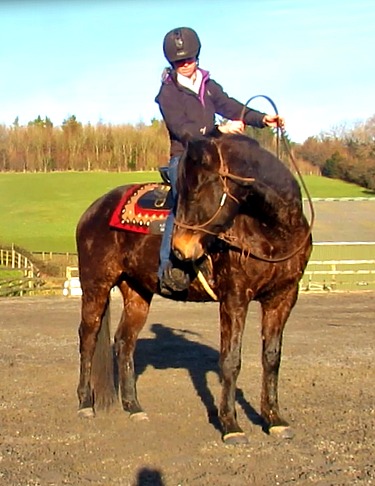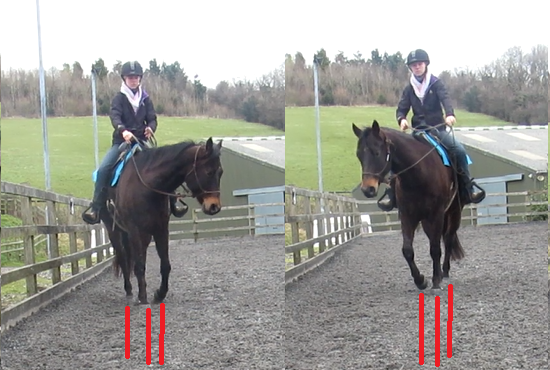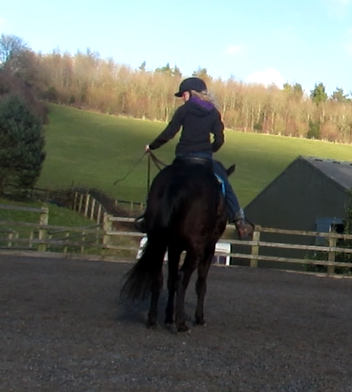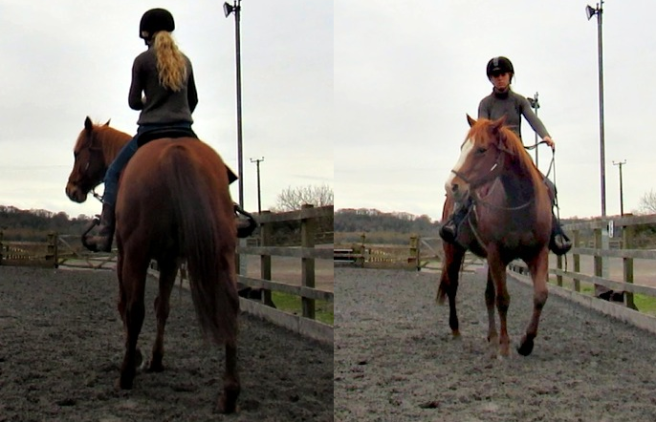C’mon, own up- I know loads of you have done it, including myself: trotting mindless 20 meter circles chanting “inside hand to outside leg” like some sort of satanic dressage druid then complaining our horse won’t bend. Many of us will have also used training aids such as the Pessoa system believing it will limber up a stiff horse, despite its lack of ability to create lateral bend, yield the quarters or anything else that actually does limber a horse up, as opposed to shoe horning it into a pseudo collected appearance and not actually solving any training issues. Thankfully, there are plenty of exercises you can do that are highly effective at stretching and suppling your horse, most of which lots of us have heard of but for some reason think that they’re too complicated or “just for dressage horses” or “just for western horses”- in reality, none of these movements were ever meant to be judged and originally came about from training war horses between battles or preparing the horses of the Vaquero cowboys for life as a functioning cowhorse able to handle long hours of labour and get out the way of a rogue bull at the drop of a hat. I’ve taken it upon myself to put forward some of the easier to digest exercises, most of which can be done at any pace and on a circle or a straight line depending on how difficult you want to make it. As an added bonus they not only work all the correct muscles, done correctly they also make your horse lighter, softer and just generally better minded.
*I’ve listed these exercises in the order I personally do them, hence the varied timeline on the pictures, but that’s entirely your choice.
*This is literally a list of exercises to give you information and ideas. It is not a step by step guide or a ‘how to’. Take it for what it is.
Lateral flexion

Have your horse stand still with his poll soft and head on the vertical while his body does a side lift. Not difficult but getting it good is extremely important. If a horse doesn’t understand something, he resists it. The reason so many horses go around with their noses poking out despite wearing all manner of crazy contraptions on their faces is because they have not been taught this simple exercise. From a bio mechanical point of view, provided your horse engages his abdominal muscles and stays on the vertical, this stretches out your horses entire top line. Simply pulling his nose around to your toe is not good enough, nor is it physically beneficial- in fact if you have to pull at all then you should stick at this exercise exclusively under saddle until you barely have to lift the rein to get the bend. If you’d like to see what I would consider satisfactory lateral flexion, there is a recent video on my facebook page, The Cardiff Quarter Bug.
Disengage Hindquarters

One your lateral flexion is very good, you can keep your horses poll flexed and apply leg at the same time.This maneuver gets the horse stepping under himself with his hind legs while his front legs travel straight and the poll is the highest point; so straight away you’re getting your horses weight off his forehand, causing the hind quarters to bare weight and the hocks to bend. This is itself makes it a baby step towards collection. There should be a bend in your horse from his poll right the way back to his loins. Getting your horse to swing his quarters away from your leg also teaches him to get off your legs, particularly if you’re consistent with the level of response you accept from him. The slower the response you accept, the slower he will be off your leg.

This is how it shouldn’t be done! Brunos head is turned but he is not stepping under himself and he is running out the side door through his left shoulder; If you’re getting this, fix it before going any further because if your horse is running his shoulder out just disengaging, not only does it put him on his forehand but he’s going to do it when you steer him, when you start worrying about canter leads, when you go onto lateral work- disengaging correctly is a step you take with you rather than a step you move on from, so skip it at your peril.
Note in this picture my hand is pulled back to my hip to guide his shoulders back into alignment rather than resting just in front of the saddle in the other pictures. My hand shouldn’t have got that high, but I didn’t shorten my rein enough so that booboo occured. My bad.
Leg yielding

Once your horse is forward and you have softness to the rein and lightness to the leg, you can start to do the cool stuff! Leg yielding is pretty much travelling forward and sideways at the same time. There should always be bend through the body to allow the horse step under himself and wrap around your leg as opposed to bracing against it. Leg yielding gets the hind end stepping under and bearing weight, front end loosened up and all the other benefits of the sidepass. However, horses that have done the sidepass to death (or done it incorrectly) can start thinking backwards because they’re not expecting any forward motion- backward thinking ultimately results in pig rooting and, at worst, rearing. Being that leg yielding is a forward motion, though it gets the horse travelling sideways it also gets him thinking forwards so is mentally a very good mental exercise as much as it is a physical one.
Shoulder in/out

Shoulder in and shoulder out are biomechanically exactly the same exercise: the horses body is bent around the riders leg and walks on three tracks so that the foreleg on the opposite side to which the horse is bending is travelling the same track as the diagonally opposing hind leg, as demonstrated in the pictures above.
Shoulder in: inside hind and outside fore walk the same track.
Shoulder out: outside hind and inside fore walk the same track.
Shoulder in bends the horse into the school, shoulder out bends the horse towards the fence. As the horse is bending away from the direction in which he is travelling, a small degree of collection is required thus making the shoulder in a good starter exercise towards achieving true collection. A horse who has never done this exercise should start with shoulder out simply because the fence will stop the horse from drifting in, meaning you can concentrate on getting the all important bend.
Back up on a circle

Here Brunos inside ear is visible and his inside hip is cocked inward slightly as he steps back. This is because the horse needs to maintain inside bend as well as move backwards- backwards is great as it gets the horse off its forehand but if you’re looking to get the hocks bending and strengthening up any weakness on a particular hind leg, that bend is what’s going to help you out. If your horse is stiff or sparse in the loin area, you’re not going to get a huge amount of inside bend initially; Bruno barely has room for a saddle, seeming to get more compact the further along his body you go, so naturally is not as bendy as some, however this doesn’t mean he won’t bend more in future. By bending the head and quarters in the same direction, this exercise actually lines your horse up for the next exercise…
Quarters in

Bruno cannot yet do more than a couple of steps of quarters in, which makes for unclear pictures. However never fear because Alfie, who is basically the Ricky Martin of quarter bugs with the range of motion he has in his hips and questionable rhythm but undeniably infectious enthusiasm, is here and he will give you an idea of what quarters in looks like. Basically you should now be able to bend your horses front and midsection, he should step under himself, so now you can start bending that rear section too! Quarters in is pretty much shoulder in with the quarters pushed in as well. Quarters in is the beginnings of your flying change and half pass, so if you want to do more impressive stuff, you need to get this down really good. Even if you don’t want to do the wow stuff, it’s still highly beneficial for your horse to be able to execute and hold this level of flexibility; the more flexible he is the less likely he is to get tightness- just ask Ricky Martin.
Rollback

Same as all the above exercises are not just for dressage horses, the rollback is not just for western horses! Done at any gait, the rollback involves (for example) walking, stopping, turning 180 degrees and going in the other direction. This one gets the horse off the bridle, thus off the forehand, transfers the weight to the hind end and is also great if you have a dull or ‘lazy’ horse as it gets them anticipating a forward movement after the turn, hence some horses get excited doing this at the faster gaits.
Not sure if anybody learned anything new there, but I only added quite a few of these exercises to my tool box over the back half of last year and they’ve been invaluable for introducing Bruno back to work after a 5 month lay off due to sacroiliac pain and kissing spines- in fact he’d been in work less than a month when most of these pictures were taken, so those of you with horses who haven’t had invasive surgery or a lay off really have no reason not to utilize the internet or the company of a good trainer and set about giving these a try. Have fun, and if you want to read more of my articles and get between blog updates, pretty pictures of the quarter bugs, and more of my writing that didn’t quite make it here you can give Bruno, Alfie and me a like on facebook at The Cardiff Quarter Bug.

Great stuff! A great checklist of activities AND what level of obedience/achievement to aim for.
LikeLike
Hi ,thankyou for putting this up ,Katie down at Lands End sent me a link , will help me with rehabilitating my horse Surprise after some SI adjustments ,fantastic
LikeLike